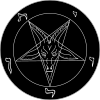The infernal names
| Part of a series on |
| LaVeyan Satanism |
|---|
 |
| Organizations |
| Notable people |
| Texts |
| Media |
| Related Topics |
|
The Infernal Names is a compiled list of adversarial or antihero figures from mythology intended for use in Satanic ritual. The following names are as listed in The Satanic Bible (1969), written by Church of Satan founder Anton Szandor LaVey.[1] When calling the names, all of them may be recited, or a given number of those most significant to the respective working may be chosen.[2] Not all were demons in their source culture; this list represents LaVey's interpretation of them and is presented below as they were written in the Satanic Bible, and therefore is prone to historical errors and personal misconceptions.[editorializing]
The Infernal Names[]
- Abaddon—(Hebrew) the destroyer
- Adramalech—Samarian devil
- Ahpuch—Mayan devil
- Ahriman—Mazdean devil
- Amon—Egyptian ram-headed god of life and reproduction
- Apollyon—Greek synonym for Satan, the arch fiend
- Asmodeus—Hebrew devil of sensuality and luxury, originally "creature of judgment"
- Astaroth—Phoenician goddess of lasciviousness, equivalent of Babylonian Ishtar
- Azazel—(Hebrew) taught man to make weapons of war, introduced cosmetics
- Baalberith—Canaanite Lord of the covenant who was later made a devil
- Balaam—Hebrew devil of avarice and greed
- Baphomet—worshipped by the Templars as symbolic of Satan
- Bast—Egyptian goddess of pleasure represented by the cat
- Beelzebub—(Hebrew) Lord of the Flies, taken from symbolism of the scarab
- Behemoth—Hebrew personification of Satan in the form of an elephant
- Beherit—Syriac name for Satan
- Bilé—Celtic god of Hell
- Chemosh—National god of Moabites, later a devil
- Cimeries—Rides a black horse and rules Africa
- Coyote—American Indian devil
- Dagon—Philistine avenging devil of the sea
- Damballa—Voodoo serpent god
- Demogorgon—Greek name of the devil, it is said should not be known to mortals
- Diabolus—(Greek) "flowing downwards"
- Dracula—Romanian name for devil
- Emma-O—Japanese ruler of Hell
- Euronymous—Greek Prince of Death
- Fenriz—son of Loki, depicted as a wolf
- Gorgo—dim. of Demogorgon, Greek name of the devil
- Haborym—Hebrew synonym for Satan
- Hecate—Greek goddess of the underworld and witchcraft
- Ishtar—Babylonian goddess of fertility
- Kali—(Hindu) daughter of Shiva, high priestess of the Thuggees
- Lilith—Hebrew female devil, Adam's first wife who taught him the ropes
- Loki—Teutonic devil
- Mammon—Aramaic god of wealth and profit
- Mania—Etruscan goddess of Hell
- Mantus—Etruscan god of Hell
- Marduk—god of the city of Babylon
- Mastema—Hebrew synonym for Satan
- Melek Taus—Yezidi devil
- Mephistopheles—(Greek) he who shuns the light, q. v. Faust (Greek)
- Metztli—Aztec goddess of the night
- Mictian—Aztec god of death
- Midgard—son of Loki, depicted as a serpent
- Milcom—Ammonite devil
- Moloch—Phoenician and Canaanite devil
- Mormo—(Greek) King of the Ghouls, consort of Hecate
- Naamah—Hebrew female devil of seduction
- Nergal—Babylonian god of Hades
- —American Indian devil
- Nija—Polish god of the underworld
- O-Yama—Japanese name for Satan
- Pan—Greek god of lust, later relegated to devildom
- Pluto—Greek god of the underworld
- Proserpine—Greek queen of the underworld
- Pwcca—Welsh name for Satan
- Rimmon—Syrian devil worshipped at Damascus
- Sabazios—Phrygian origin, identified with Dionysos, snake worship
- Sammael—(Hebrew) "venom of God"
- Samnu—Central Asian devil
- Sedit—American Indian devil
- Sekhmet—Egyptian goddess of vengeance
- Set—Egyptian devil
- Shaitan—Arabic name for Satan
- Shiva—(Hindu) the destroyer
- Supay—Inca god of the underworld
- T'an-mo—Chinese counterpart to the devil, covetousness, desire
- Tchort—Russian name for Satan, "black god"
- Tezcatlipoca—Aztec god of Hell
- Thamuz—Sumerian god who later was relegated to devildom
- Thoth—Egyptian god of magic
- —Scandinavian female devil
- Typhon—Greek personification of Satan
- Yaotzin—Aztec god of Hell
- Yen-lo-Wang—Chinese ruler of Hell
See also[]
- Anton Szandor LaVey
- Church of Satan
- LaVeyan Satanism
- Left-hand path and right-hand path
- Luciferianism
- Satanism
- The Satanic Bible
- The Satanic Temple
- Theistic Satanism
References[]
- ^ LaVey, Anton Szandor (1969). The Satanic Bible. Harper Collins. pp. 58–60. ISBN 978-0380015399.
- ^ LaVey, Anton Szandor (1969). The Satanic Bible. Harper Collins. p. 145. ISBN 978-0380015399.
Categories:
- 1969 documents
- Satanism
- Astarte
- Religion-related lists